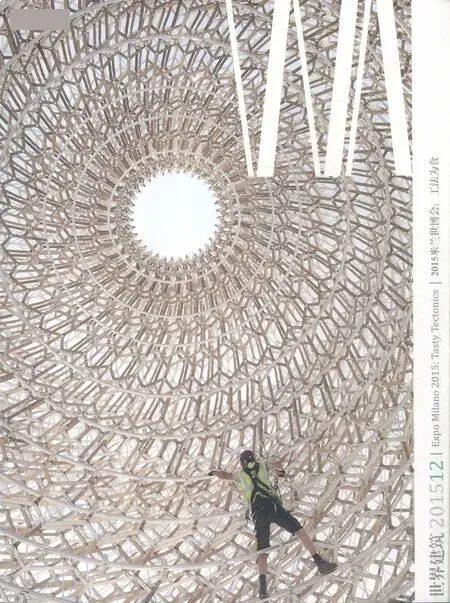整合形象:英国馆
建筑及艺术设计:沃尔夫冈·巴特斯
Artist: Wolfgang Buttress
整合形象:英国馆
Integrated Image: UK Pavilion
建筑及艺术设计:沃尔夫冈·巴特斯
Artist: Wolfgang Buttress

1 有参观者的夜景/Night view with visitors
导言
英国馆揭示了世界蜜蜂数量锐减的问题,并强调了授粉对食品生产的重要性。徜徉在果园中的游客会看到一大片野花,随即走进“蜂巢”。这个闪闪发光、嗡嗡作响的雕塑力图模拟的是一个真实的蜂巢。英国馆将养蜂生态阐释为一种沉浸式的多感官体验——一次美丽而含义深远的邂逅——让英式景观在游客的心中回味无穷。
概念
蜜蜂对所处的环境非常敏感,因此被视作生态小卫士:地球健康的晴雨表。
呼应世博会的主题,我们选择了食品链上不可或缺而又常常被忽视的一环:授粉过程是一个关键,支撑着至少1/3的食品生产。然而,蜜蜂这个重要的传粉者正面临着危机。在过去的10年中,我们目睹了全球蜜蜂数量的锐减。1986-2005年,英国共减少了30%的蜜蜂,而意大利是40%。最近欧盟的研究显示29%的英国蜜蜂群落在2012/2013年冬季消亡,这是前所未见的损失。其原因在于杀虫剂、病害和生境减少等多种因素。1950年代以来,英国失去了约97%的原生草地,转而用于建筑和农业。
英国馆关注的正是解决这些问题的必要性,以及延续我们发展至今并赖以生存的古老生态机制的重要性。
设计师与蜜蜂专家马丁·本奇克博士组成了团队。他正在利用能更好地理解蜜蜂群落行为的技术进行前沿研究。通过测量振动信号,本奇克就能确定群落的状况,并预见群飞现象。这是一个重要的进步。该研究将有助于利用新的监测技术辅助养蜂,进而形成支撑蜜蜂的更大战略,为食品安全、生态和经济带来更大收益。
这一问题对于英国尤为重要,因为我们的蜜蜂数量在近来世界的下行趋势中受到的影响最大。与此同时,养蜂仿佛又重新兴起,很多人在屋顶上进行业余养蜂。养蜂的未来在于以本土化的方式复兴,而技术的进步将为其助力。
英国馆的大愿景来自一位艺术家的感悟,试图将游客与大自然和生态系统在体验上联系起来。这一设计以沃尔夫冈之前的作品为基础,向新的领域拓展。该项目在选定的视角和主题之下经过了反复设计。
设计团队在工作上以主题和游客体验为中心,实际上是完全自主的。无背景介绍的任务书所要求的是自成一体的设计。团队对这个没有限定的条件的第一反应是创造一个新的文脉:将英国的乡村移植到米兰来。核心区序列从果园、草地、台地酒吧到焦点上的“蜂巢”,共同构成了游线。
体验的过程完全在室外,并被赋予一种宁静、甚至是崇高的意境。蜂巢从入口退后一段距离,作为穿越风景的游线的终点。从世博会的“东西大道”上就能望见蜂巢,吸引游客来此领略奇观。草地被升到人眼的高度,造成一种“蜂瞰”鲜花的效果。其用意在于营造一种融入自然、与蜂共鸣的通感。
不同的线路和场地让游客能自由探索属于他们的旅途。其中的感受是无限定的,因为人的主动体验是最具灵性的。正是这一原则给英国馆带来了诸多灵感。此外,感官的调动也很关键:嗅觉、触觉、听觉和视觉。
结构
蜂巢由32层水平叠加的六边形组成。这一构成蕴含着理性的秩序和旋转对称。形体中错层叠置的放射线和弧线与压力流向相符,并决定了结构的水平线。雕塑的分层让结构的放射线和弧线连结成桁架,在六边形中的重复进而表现为宏观上的韵律。
为了突出雕塑的水平分层,桁架的顶弦和底弦都是用金属平板条切出的。而连结顶弦和底弦的支撑是小金属管或金属杆。其中的连结靠的是机器加工的节点。结构为全支撑,减少了材料,也就意味着连结节点不需要抗弯。为了达到最佳的功效(就像自然一样),创造一个精巧别致的结构,我们提出每个构件,即桁架中的金属板、金属管或金属杆,都不超过所需的宽度,从而在微观上形成变化。
桁架虽在宏观上是重复性的形体,但每一个都要根据内外表面单独修剪。再加上构件的不同尺寸,1000多个桁架几乎无一相同。
设计决定了蜂巢要有数以万计的不同构件,它们的尺寸要根据一百种不同的荷载组合来确定。此外,蜂巢还要在短时间内反复设计,经历一个快速的数字式达尔文进化。
这种进化只能靠写软件来实现。我们认为,设计中的每项任务都会重复多次,所以尽量采用自动化的方式。最后,一个包含了详细分析模型、设计标准校核、7万多构件的结构优化以及轮廓图的完整设计可以在几天之内修改完毕。在一般的项目中,这需要几个月,而且往往只做一次。
快速修改和测试设计的能力意味着方案可以适应极端情况,甚至是同时将所有材料从不锈钢改为铝、用新造型满足连结设计的变化,并且是节省20%成本的多次颠覆性设计。
最终确定的方案生成了1500个实体CAD模型,其中包括30,000个带有全部加工细节的构件。然后,承包商Stage One就可以用他们已有的3D工作程序和管理系统处理这些模型,再由CNC机器加工。蜂巢总共由169,300个机器加工的铝材建造而成。
蜂巢有模数化的结构,由构件装配而成,在英国加工之后运到米兰,现场组装。其目的在于让蜂巢回归英国之后能“重获生机”,而这从最初的设计开始就是一个关键原则。
景观
这个旅行从一片苹果园开始(它是需要蜜蜂授粉的),下面满是耐阴的鲜花。果园两侧是木板围墙——“信息墙”和“蜂群墙”。上面排满了一群小洞,让人联想到蜂群和“蜜蜂旅店”。游客随即穿过狭窄的过度空间,颇有一种“神秘园”的感觉。之后豁然开朗,一片花海映入眼帘。从平面上看,小径呼应着远端“蜂巢”雕塑的六边形主题。它在这美景之中展开,形成放射状的道路和布局。这种关系在地板中的嵌饰上一目了然。周围是更为规则的“蜂缘”绿化带。其中的植物有各个品种的薰衣草,让人仿佛闻到英国乡村花园和伯爵茶的味道。事实上,薰衣草也是蜜蜂的最爱。
花海中各式各样的植物织成一片完美的地毯,铺在起伏多变的大地之上。婆娑的草地和高大的常青树构成的图案赋予丰富的地形奇妙的生命。为了营造这样的效果,一片预先种好鲜花的草皮满铺在地上,之后种上植物,从而形成特色各异的区域。植物的品种是根据花蜜的丰富程度和季节特色选择的:例如顶着大黄花、高高的猫耳菊,蓬松轻柔、薰衣草色的欧洲山萝卜,还有叶裙丰茂、有品红色球状花的红菽草。这诸多品种都是与邱园一同精选出来的,他们丰富的专业知识为项目添色不少。
植物是有季节性的,在世博会的半年中会不断变化。我们的计划是展示这种循环,并培养人们去欣赏不同时节的风韵。
这个方案的亮点是植物绚烂的效果,也就是某些品种的植物针对某种需求的生态实用性。景观成了设计的宣言书,同时也是为保护授粉者创造滋养它们的植物生境的范例。仅在开幕的一个月中就有无数蜜蜂飞到这片花丛来。
建筑与室内
台地酒吧与下方会议套房的建筑厚实谦逊,全无多余的细节。整座建筑以900mm的通用模数构成了自然的韵律。分模数则用于楼梯踏步和立板、窗洞口、门铁顶和挂板,而这一切都回归到统一的秩序上——一个蜂巢高效的秩序点。
在建筑内部,中间是一个六边形单元,室内设计都围绕它展开。这是一个多功能的空间,可以举办临时展览、商务洽谈或召开会议。精心的设计将辅助空间组织在一起,又能保持相互独立,满足不同的功能,使有限的空间得到充分的利用。邻近关系、游客流线以及公共和私密空间和路线的分布也进行了仔细的考虑。公众、办公员、厨师、贵宾、货运和垃圾都有不同的出入口。建筑为游客在室内提供了明显的标志,并在室外呼应着轻巧的蜂巢雕塑。
外立面的处理大气磅礴。穿孔耐候钢板遮住高窗,镜面百叶板挡住低窗,尽可能不影响整体给游客的安静印象。酒吧也采用了类似的手法,让人们一走上通往蜂巢的屋顶平台就能看到它。厚重的屋顶板盖住酒吧,为人们遮风挡雨。一个镜面金属层让人既能前眺蜂巢又能回望景观。
随着以人工智能、互联网+、大数据等为代表的互联网技术的深入发展,互联网思维这种包含对用户、产品等进行重新审视的思维方法出现。互联网思维具有平等性、互动性、开放性、合作性、平台性等特点,强调开放、透明、高效、平等和去中心化等,是一种系统性思维方法,对新时期社会经济、文化、政治提供一种新的阐述视角。
材料
选用的材料基本都未经处理,会长出自然的绿锈。这种原生态是一个关键。一旦建成,命运就交给了风和雨,而建筑材料的本性会让它继续生长。
锈蚀的耐候钢有一种乡土的色调,与植物和蜂巢结构的轻巧对比鲜明。温暖的镜面金属层增加了进深感,通过各种反射角将不同区域联系起来。带百叶窗的墙面影射传统的蜂巢。胶合板与花旗松能带来柔软的质感,久之还会变成银色。地板的处理全为树脂粘结的砾石,带来一种松脆的感觉,仿佛走在沙石地上。蜂巢选用铝有多种原因:轻质,结构性能良好,成本低,抗腐蚀,而且易于机器加工。□(尚晋 译)
Introduction
The UK Pavilion highlights the decline of the world's bee population focusing attention on the importance of pollination for food production. Visitors meander through an orchard, discover a wildflower meadow and enter "the Hive", a sculpture which glows and hums, simulating conditions in a real beehive. The Pavilion reinterprets apiarian ecology as an immersive multisensory experience – a beautiful and profound encounter – leaving visitors with a lasting flavour of the British landscape.
Concept
Bees are very sensitive to their environment and can be seen as ecological sentinels: a barometer for the health of the earth.
Responding to the Expo theme, we have chosen to focus on a vital and often neglected part of the food picture: Pollination is an essential process, underwriting at least a third of our food production. Yet the honeybee, an important pollinator, is in crisis. We have witnessed massive declines in global bee populations over the past decade. The UK has seen an overall decline in bees of 30% between 1986 and 2005, while in Italy the decline has been over 40%. Recently, EU research revealed that 29% of British honeybee colonies died out in the 2012/13 winter, an unprecedented loss. This trend is the result of a combination of factors including pesticides, disease and loss of habitat. Since the 1950s the UK has lost around 97% of its wild meadows to building and agriculture.
The UK Pavilion focuses on the need to address these problems and the importance of sustaining ancient ecological mechanisms which we have evolved within and rely heavily upon.
The designers teamed-up with bee expert Dr. Martin Bencsik who is undertaking cutting-edge research using technology to better understand the behaviour of honey bee colonies.
By measuring vibrational signals Bencsik can determine the condition of a colony and predict swarming, which is a significant step forward. Such research will aid the task of bee keeping through development of new monitoring technology. This in turn could form part of a wider strategy to support the bee, bringing great benefits in terms of food security, ecology and economy.
This issue is of particular importance to the UK as our bee population is among the worst affected in the world by the recent downward trend. At the same time there has been something of a renaissance of interest in bee keeping with many people taking up amateur rooftop bee keeping. The future of bee keeping is being revitalized in localized ways, and new advances in technology could assist in this.
The overall vision for the UK Pavilion comes from an artist's sensibility. It seeks to connect the visitor with nature and ecosystems on an experiential level. The design builds upon Wolfgang's previous work, extending this into new territory. The project evolved through many iterations of design, guided by the chosen angle and underlying theme.
The design team were given a virtual carteblanche to design around a theme and visitor experience. The a-contextual nature of the brief called for something self-contained and coherent in its own right. The team's initial response to this undefined condition was to create a new context: to graft a slice of the British countryside onto the site in Milan. A sequence of key areas including, an orchard, meadow, terrace-bar and the focal "Hive", together comprise the visitor journey.
The experience is intentionally entirely external and is intended to be quiet, almost subliminal. The Hive is set back from the entrance, creating distance and serving as the culmination of a journey through the landscaped areas. The Hive may be glimpsed from the main "Decumanus" Expo thoroughfare generating intrigue and inviting visitors to enter and discover. The meadow is raised to eye-level giving a kind of "bees-eye view" of the wildflowers. The aim is to impart a sense of being within nature, to foster a sense of empathy, humility and connectedness.
Multiple routes and places allow the visitor to explore and participate in the curation of their own journey. The experience is deliberately non-prescriptive, based on the premise that an experience is most insightful when people actively engage. This principle has informed many aspects of the Pavilion. Use of the senses was also key, engaging the olfactory, haptic and aural as well as the visual faculties.
Structure
The Hive consists of 32 horizontal stacked layers of hexagonal geometry. This pattern has a rational underlying order and employs rotational symmetry.The geometry was resolved into alternating layers of radial and circumferential elements. The pattern of radial and circumferential lines is analogous to the flow pattern of stress and so defines horizontal lines of structure. The layering of the sculpture allows these radial and circumferential lines of structure to be joined to form truss like assemblies. This repetition within the hexagonal pattern allows the truss assemblies to provide repetition on the macro scale.
The bottom and top chords of each truss are cut from strips of flat plate to emphasize the horizontal layering of the sculpture while the brace elements joining the top and bottom chords are, in contrast, small tubes or bars. Connections were made mechanically using a machined node. The structure is fully-braced, which helped reduce material and meant that connection nodes didn't need to resist bending. In an attempt to achieve a level of optimal efficiency (as encountered in nature) and thereby produce a filigree and delicate structure we proposed that each individual component, i.e. segment of plate, tube or bar within each truss would only be as wide as it needed to be, producing variation on the micro scale.
Each truss, although based on a macro repetitive geometry, would also have to be individually trimmed to the internal and external surfaces. The trimming combined with the varying sizes of the component parts, made every one of the 1000 or so trusses potentially unique.
It was resolved that the Hive was going to have many tens of thousands of possibly unique parts. These parts would have to be individually sized to carry the forces experienced under a hundred different combinations of loading. It was also conceded that the Hive would need to be re-designed over and over again and it would need to happen in a short amount of time, a quick digital Darwinian process.
The process could only be achieved by writing software. We assumed that every task in the design would have to be carried out time and time again and so each task was automated as much as possible. Eventually a complete re-design involving detailed analysis models, design code checking, structural optimization of 70,000+ elements and outline drawings could be turned around in a few days. On a conventional project this can take months and typically only happens once.
This ability to change and test the design quickly meant that the design could adapt to extreme events including a complete change in material from stainless steel to aluminium, new geometries to accommodate changes in connection design and multiple complete redesigns to achieve savings of 20% at a time.
The design information when finally fixedwas used to generate 1,500 individual solid CAD models containing over 30,000 individual parts fully detailed for fabrication. The contractor, Stage One was then able to take these models and process them through their existing 3D workflow and management system to supply to their CNC machines for fabrication. The Hive is constructed from a total of 169,300 machined aluminium components.

2 夜间内景/Interior view at night
The Hive is a modular structure, a kit of parts, made in the UK and then shipped to Milan for assembly on site. The intention is for the Hive to have a "second life" back in the UK and this was designed in, as a key principle from the outset.
Landscape
In response to the difficulties that bees face, we proposed a wildflower feast for pollinators, providing a space for this crucial mechanism at the Milan Expo. The landscape forms a core aspect of the UK Pavilion, covering around 60% of the site area. Planting is a natural foil to the precisely-engineered Hive sculpture which forms the focal point of the Pavilion. We sought to transport the visitor into the world of the honeybee, creating a journey through archetypal British landscapes.
The journey begins in an Orchard area with apple trees (dependant on pollination by bees) under-planted with a carpet of shade-tolerant wildflowers. The Orchard is bounded on two-sides by timber panelled walls, the "information wall" and "swarm wall". These play host to a swarm-like array of small holes, evocative of a swarm and in reference to "bee hotels". The visitor then moves through a narrow transitional space, evoking notions of the "secret garden", before emerging into a rolling wildflower meadow. In plan, the meadow paths continue the hexagonal motif of "the Hive" sculpture, sited at the far end, which seems to radiate into the landscape, informing routes and layouts. An inlay set into the floor makes this connection explicitly. A more formal planting strip, the "BE Fringe", runs around the perimeter. This planting consists of different lavender species, evocative of the English country garden and Earl Grey tea. Lavender is also a favourite of bees.
Planting within the meadow is designed as a rich tapestry of types, merged into one seamless, undulating landform. Varying topography is accentuated using swathes of textured grasses and tall perennials. To achieve this, a single pre-sown wildflower turf was laid throughout the meadow, into which plug plants were inserted, creating

3 景观总体规划/Landscape masterplan
1-“蜂巢”雕塑/Bee hive sculptural piece
2-果园/展馆入口/Orchard/pavilion entrance
3-野花中的小径/Wildflower meadow walk
4-野花草地/Wildflower meadow
5-平台坐席/Terraced seating
6-活动空间(下层空间)/Event space (beneath space)
7-通向屋顶平台的台阶/Step access up to roof terrace
8-电梯/Lift
9-屋顶平台/Roof terrace
10-通向首层的台阶/Step access down to ground floor
11-进入蜂巢的通道(屋顶层)/Bee hive access walkway (at roof level)
12-售票处/Ticket office
13-酒吧/商店/Roof to bar/shop
14-东西大道/Decumanus
15-残障人士入口/Disabled visitor access
16-紧急出口/Emergency exit
17-灌溉池检查口(草地下方)/Access cover to irrigation tank (beneath meadow)
18-展馆出口/Pavilion exit
19-贵宾通向贵宾室和会议室的入口/VIP entrance to lounge and conference facilities
20-限制入内区域/Restricted access area
21-从东西大道进入果园/Entrance into orchard from decumanus
22-员工通道至售票处/Staff access to ticket office
23-售票处/Ticketing kiosk
24-变压器室(草地下方)/Transformer room (beneath meadow)

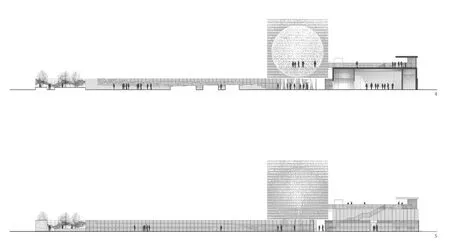
4.5 长剖面/Long sections
25-座位/变电站检查口/Seating/access cover over sub-stationdifferent character areas. Plant species were selected for their richness in nectar and seasonal interest: the Cat's Ear (Hypochaeris radicata), for example, with its large yellow flowers reaching for the sky, the Field Scabious (Knautia arvensis) with its delicate pom-pom-like lavender coloured flowers, and the Red Clover (Trifolium pratense), with its abundance of lower growing, ball-like magenta flowers. These, and all the other species used, were chosen in collaboration with Kew Gardens, who brought the wealth of their expertise to the project.
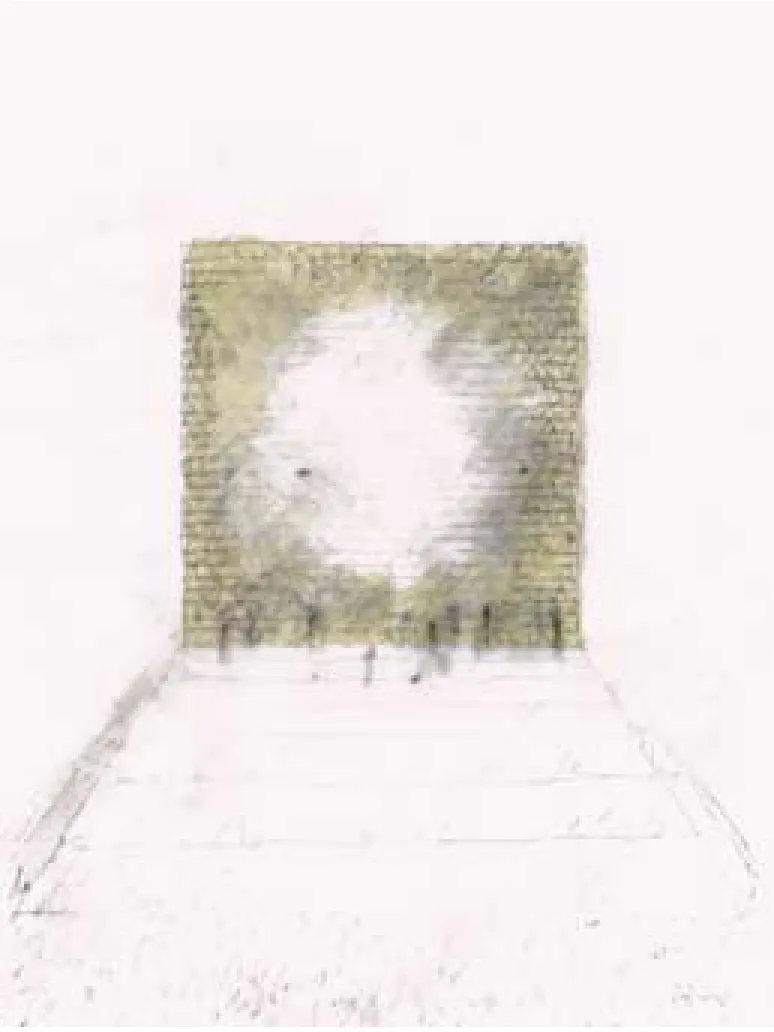
6 蜂巢生成草图/Hive development sketch
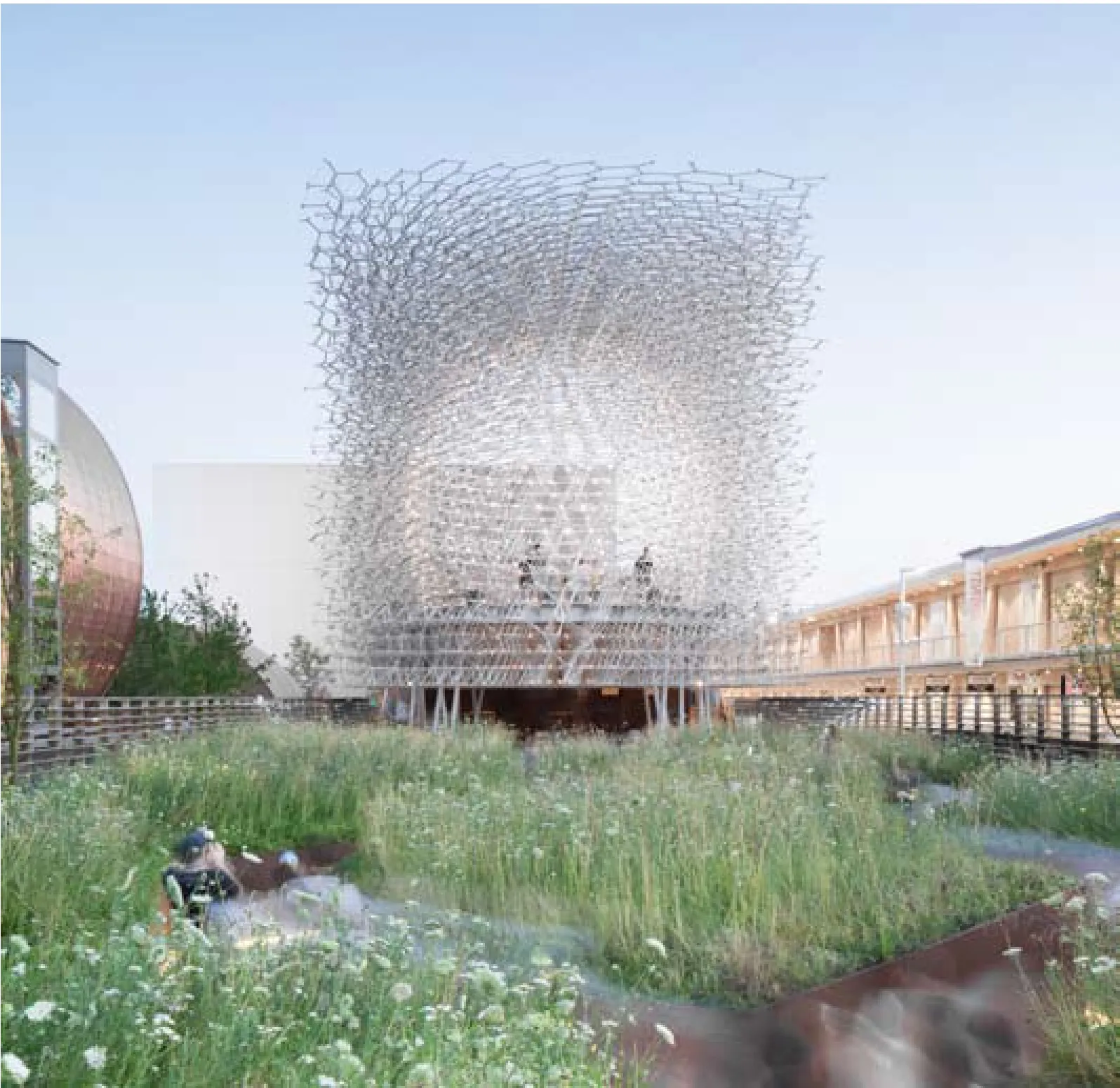
7 外景/Exterior view
The planting is seasonal and will change throughout the six-month duration of the Expo. Part of our agenda is to showcase this cycle and cultivate an appreciation of the charms and character of the different stages.
The scheme focuses on the performative aspects of planting, that is, the ecological usefulness of certain types of plants for a specific need. The landscape serves as a representation of the project manifesto and serves as an example of the type of planting that can assist in creating nutritious habitats to sustain the vital pollinators. Many bees have been seen visiting the meadow during the opening month alone.
Architecture & Interiors
The architecture of the terrace-bar and conference suite beneath, is unapologetically solid and understated, minimal in the detail. A common 900mm module is set to provide a natural rhythm throughout the building, with smaller modules being subdivided, setting stair treads and risers; window opening sizes; door ironmongery heights and cladding panels, all linked back to a unifying order, a nod to the efficient ordering of honeycomb.
Within the building, a single hexagonal cell is positioned centrally, with the internal planning developed around this. It provides a multifunctional space through which temporary exhibitions can be held, business meetings attended or conferences presented. Careful planning allows support spaces to cluster, but remain independent to meet functional requirements, making efficient use of the limited area. Careful consideration was given to adjacencies, user flow and the distribution of private and public spaces and routes. Multiple separate entrances are provided for public, office staff, kitchen staff, VIPs as well as stock delivery and waste removal. The building provides obvious markers for users internally and a counterpoint to the lightness of the sculptural Hive externally.
The external facade treatment is monolithic, with high-level window openings positioned behind perforated Corten steel cladding, and at low level, behind mirrored louvered panels, so as to minimise the impact on the visitors' quiet impression of a unified whole. A similar approach is taken with the bar, which greets visitors as they emerge onto the rooftop terrace en route to the Hive. A heavy roof plane covers the bar area providing shelter from the elements, with a mirror-like metallic finish focusing on the experience back towards the Hive and the landscape beyond.
Materials
The materials used are generally unprocessed and will get patinated naturally. This rawness was a key principle. Once built, the weather takes over and the materiality of the pavilion continues to evolve.
Weathered Corten steel has a rustic earthy hue, contrasting nicely with the delicacy of the planting and Hive structure. Warm metallic mirror finish gives the impression of greater depth connecting various areas through reflected glimpses. Louvered walls reference the traditional beehive. Plywood and Douglas fir bring softness and will silver over time.The floor treatment is resin-bound gravel throughout, creating a kind of crunchy feel, like walking across stony ground. Aluminium was selected for the Hive for many reasons: it is lightweight with favourable structural properties, cost, is corrosion resistant and can be machined easily. □


项目信息/Credits and Data
艺术设计及创意总监/Artist and Creative Lead: Wolfgang Buttress
场馆建造/Pavilion Manufacture and Production: Stage One结构工程师/Structural Engineers: Simmonds Studio
建筑景观及环境工程/Architecture, Landscape Architecture and Environmental Engineering: BDP
物理学家及蜜蜂专家/Physicist and Bee Expert: Dr Martin Bencsik
摄影/Photos: Hufton+Crow(fig.1,2,9,11), Mark Hadden(fig.7,8,10)
评论
陈浩如:狭长规整的地块犹如期待被打破的城市网格, 英国似乎在此营造城市花园:从小庭院入口,曲折如英式花园,进入颇具透视感的长形空间,花坛从地面凸起,构成六边形的迷宫,观者从中回绕,行往灭点处虚幻的蜂巢。艺术家与工程师合作完成了一座金属的大体量蜂巢建构,无数金属构件交缠一体模糊了建筑物的界面、轮廓和空间,使观者犹如归巢的蜜蜂恨不得长出翅膀能占据这场所。内部球体空间指向艾蒂安·布莱在1784年幻想的牛顿纪念馆,和启蒙时代的理性与进步狂热。材料细节带来的强烈感官冲击显然并非追求一种和谐的表达。建筑师所熟知的空间典故和理性和谐的建筑传统,被艺术家组合最大程度地挑战了。
刘晨:如果不算上帝,蜜蜂该是自然界最伟大的建筑师。不知有多少人想从一只蜂窝那里汲取灵感,在人类世界演绎这奇特的结构,然而总是差强人意。我们无法亲身感受蜜蜂筑巢的行为,就好比我们无法想象蜜蜂“复眼”中的世界是何模样,尽管蜂窝和复眼最终都归于一个简单的六边形。除非让自己做个梦,在梦里我们都变成蜜蜂。英伦达人真就造了这样一个梦,一个巢,一只眼。在六边形的无穷迭代里,已无所谓空间和边界。蜜蜂有一对复眼和3个单眼,但对人类来说,“美目一只足矣”。
Comments
CHEN Haoru: Just like a broken city grid, the regular narrow block was done as expected. It seems that the British is trying to create an urban park: from the small courtyard entrance, twists and turns as an English garden, enter into a quite perspective elongate space. Flower beds raise from the ground to form a hexagonal-shaped maze, which wrap around the viewer whom will then go off-line at the point of fantasy hive. Artists and engineers completed the construction of a large volume of metal honeycomb, and numerous metal integrally intertwined and blurred the interface, outline, and the space of the building, so that the viewer feeling themselves as homing bees will desire to grow wings to occupy this place. The inside space formed a Newton Memorial fancied by Etienne Boullée in 1784, which seems that it is pointing to the rationality and progress craze during the Age of Enlightenment. Strong sensory impact brought by material details is obviously not pursuing the expression of a harmonious. Space allusions and rational architecture convention in the architect's knowledge were furthest challenged by artist combination.
LIU Chen: Bees may be regarded as the most capable architect in nature. The beehive has long been a source of inspiration for humans to create similar structures, though the outcomes are barely convincing. We cannot experience the little bee's behavior of hiveconstruction, nor can we imagine what the world looks like in their compound eyes, even though both the hive and the compound eye derive essentially from a simple hexagon. Unless it happens in a dream, in which we humans are metamorphosed into bees. At the 2015 Milan Expo, some British talents have literally created such a dream with a structure that calls to mind both a beehive and a compound eye. In its infinite iteration of hexagons, neither space nor boundary matters. A bee has three monocular eyes in addition to one pair of compound eyes, but for humans "one beautiful eye would suffice".
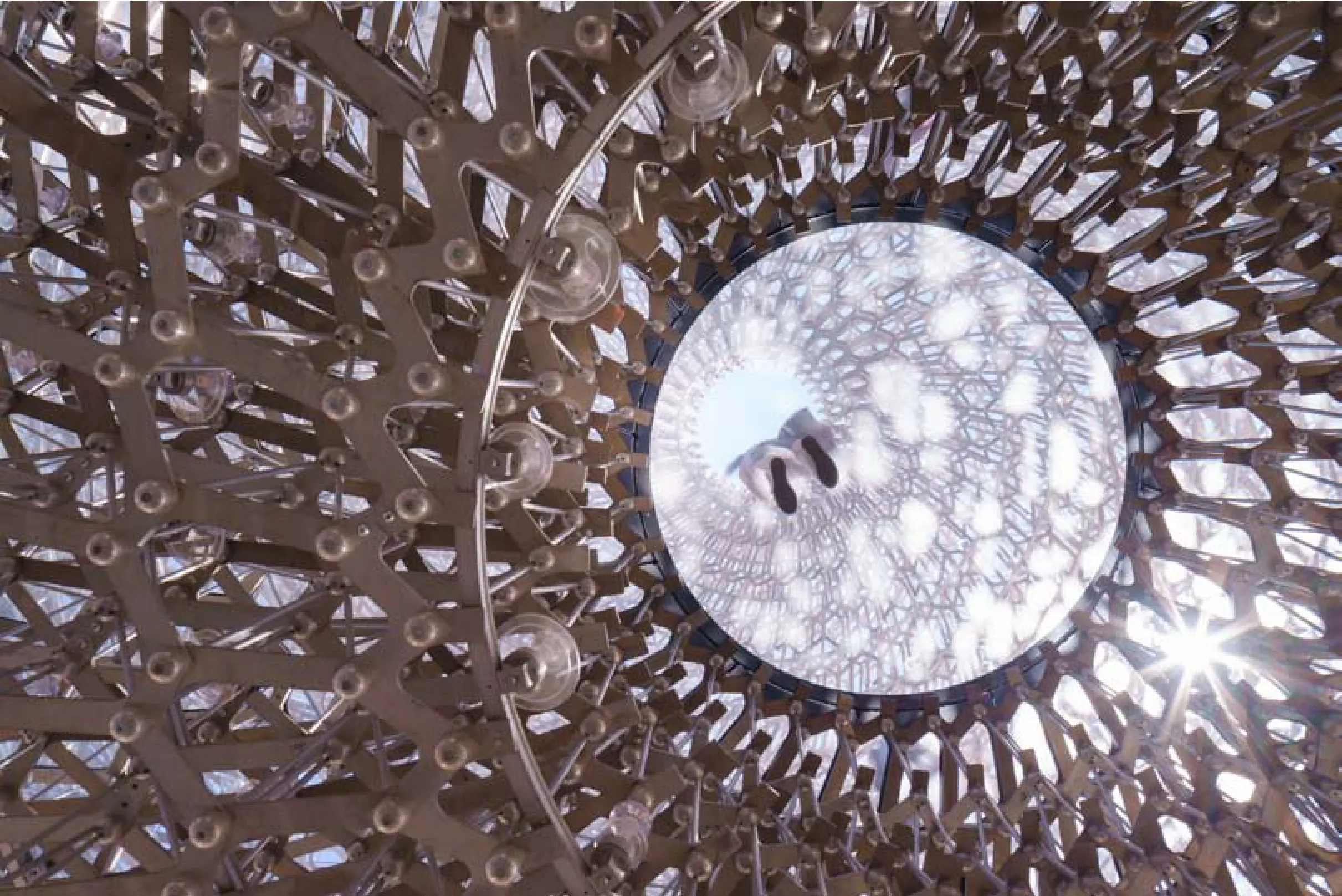
8-10 蜂巢底部/Under the hive
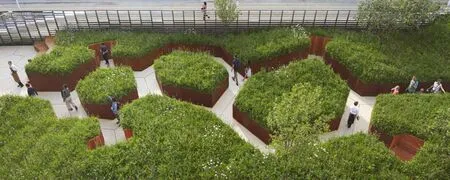
11 草地/Meadow

